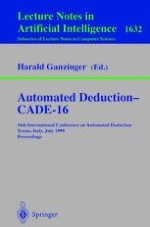1999 | Buch
Automated Deduction — CADE-16
16th International Conference on Automated Deduction Trento, Italy, July 7–10, 1999 Proceedings
verfasst von: Harald Ganzinger
Verlag: Springer Berlin Heidelberg
Buchreihe : Lecture Notes in Computer Science
Enthalten in: Professional Book Archive
